The source code to reproduce the results of this blog post can be found here
Introduction🔗
Making relevant groups of students, for doing some practical exercises for example, or in problem-based learning, is one common problem for teachers. Groups must not be too small, or too large, and the mean “level” of each group should be as homogeneous as possible. We don’t want one group with only students in difficulty and one group with only “good grades” students. In addition, students in each group should get along with each other, and all participate in solving the exercises.
Generally, we just let the students make their own groups with some size limitations, or we just do random groups.
Obviously, it’s quite sub-optimal.
A possible way should be to use a metric (grades, IQ, etc.) to evaluate students and make groups according to this metric. To illustrate this post, I decided to use the “Reading the Mind in the Eyes” Test (RMET) proposed by Warrier, Bethlehem, and Baron-Cohen (2017). This test aims to evaluate the “emotional”/“social” intelligence of the subjects. According to Riedl et al. (2021), a high social perceptiveness of group members is quite correlated to a high collective intelligence. So, why not use RMET as a base to construct groups of students?
Let’s first generate some random RMET scores to represent our students. In my case, I’m teaching 18-25 years old students at university. According to Kynast et al. (2021), the mean RMET score for this age range is 26 (with a standard deviation of 3.2).
# set seed to reproduce results
seed <- 42
set.seed(seed)
# generate random RMET scores for each student
nbStudents <- 20
students <- data.frame(
id=1:nbStudents,
rmet=round(rnorm(nbStudents, mean=26, sd=3.2))
)
knitr::kable(students, "pipe", align="cc")
| id | rmet |
|---|---|
| 1 | 30 |
| 2 | 24 |
| 3 | 27 |
| 4 | 28 |
| 5 | 27 |
| 6 | 26 |
| 7 | 31 |
| 8 | 26 |
| 9 | 32 |
| 10 | 26 |
| 11 | 30 |
| 12 | 33 |
| 13 | 22 |
| 14 | 25 |
| 15 | 26 |
| 16 | 28 |
| 17 | 25 |
| 18 | 17 |
| 19 | 18 |
| 20 | 30 |
Now, we want to distribute these students into several groups in the most homogeneous way possible, with a minimum and a maximum number of students in each group.
minStudentsByGroup <- 3
maxStudentsByGroup <- 6
Based on these minimum and maximum numbers of students by group, we can easily know the minimum and maximum numbers of groups we can hypothetically create.
# we round to the nearest value up with ceiling function
# because if nbStudents %% maxStudentsByGroup != 0, we need an additionnal group
nbGroupsMin <- ceiling(nbStudents / maxStudentsByGroup)
cat(nbGroupsMin, "\n")
4
# we don’t care of nbStudents %% minStudentsByGroup in this case
# because groups are not full
nbGroupsMax <- nbStudents %/% minStudentsByGroup
cat(nbGroupsMax)
6
This problem can be seen as a variation of the knapsack problem. However, instead of choosing which item to put in a unique bag, we want to take all the items and distribute them as homogeneously as possible into several bags. The knapsack problem is an NP-hard problem. So, we can suppose that our variation of this problem is also NP-hard. Testing all the possible solutions is then not an option, it’s too time-consuming.
A possible way to solve this problem is to use a “meta-heuristic” algorithm. As described by Abdel-Basset, Abdel-Fatah, and Sangaiah (2018), meta-heuristic algorithms compose a subclass of algorithms dedicated to exploring the scope of possible solutions for a specific problem. They are based on heuristics on how to explore solutions to problems in general, and not on heuristics to solve a specific problem (hence the “meta”).
One of these meta-heuristic algorithms is the Genetic Algorithm. It’s a bio-inspired algorithm (Fan et al. 2020) based on the theory of evolution (AKA: the most adapted to its environment will survive). The genetic algorithm emulates the process of species selection to explore solutions to a problem, its main “meta-heuristic” being: it works for species to find relevant adaptations to their environments, so why not for algorithms to find relevant solutions to a problem?
The genetic algorithm, as we’ll see in this blog post, is quite adapted to explore solutions to problems for which we have several parameters, we can evaluate an output score, and for which we want to know the combinations of parameters that maximize (or minimize) the output score.
In our use case, we have several ways to group students (parameters) and we want to find the most homogeneous ones (output score). Therefore, using a genetic algorithm seems quite adapted. It is also the occasion to test, and explain step by step, a genetic algorithm with a practical use case.
Naively apply basic genetic algorithm🔗
To apply a basic genetic algorithm to our problem, we need to define two things:
- parameters that describe our problem, also called “solutions”
- our output score to evaluate a solution, also called “fitness”
The genetic algorithm will then explore possible solutions, evaluated their fitness, and try to find the most optimized solutions.
Representing our solutions🔗
First, let’s define how to represent possible solutions to our problem. In the case of a binary genetic algorithm, this means that each parameter can only be set at 0 or 1. A solution to our problem can be seen as a matrix. Each row corresponds to a group and each column corresponds to a student. If a student is affected to a group, the corresponding cell is set at 1. Else, the cell is set at 0.
example <- c(
1, 1, 1, 1, 0, 0, 0, 0, 0, 0, 0, 0, 0, 0, 0, 0, 0, 0, 0, 0,
0, 0, 0, 0, 1, 1, 1, 1, 0, 0, 0, 0, 0, 0, 0, 0, 0, 0, 0, 0,
0, 0, 0, 0, 0, 0, 0, 0, 1, 1, 1, 1, 0, 0, 0, 0, 0, 0, 0, 0,
0, 0, 0, 0, 0, 0, 0, 0, 0, 0, 0, 0, 1, 1, 1, 1, 0, 0, 0, 0,
0, 0, 0, 0, 0, 0, 0, 0, 0, 0, 0, 0, 0, 0, 0, 0, 1, 1, 1, 1,
0, 0, 0, 0, 0, 0, 0, 0, 0, 0, 0, 0, 0, 0, 0, 0, 0, 0, 0, 0
)
knitr::kable(matrix(example, ncol=nbStudents, byrow=TRUE), "pipe")
| 1 | 1 | 1 | 1 | 0 | 0 | 0 | 0 | 0 | 0 | 0 | 0 | 0 | 0 | 0 | 0 | 0 | 0 | 0 | 0 |
| 0 | 0 | 0 | 0 | 1 | 1 | 1 | 1 | 0 | 0 | 0 | 0 | 0 | 0 | 0 | 0 | 0 | 0 | 0 | 0 |
| 0 | 0 | 0 | 0 | 0 | 0 | 0 | 0 | 1 | 1 | 1 | 1 | 0 | 0 | 0 | 0 | 0 | 0 | 0 | 0 |
| 0 | 0 | 0 | 0 | 0 | 0 | 0 | 0 | 0 | 0 | 0 | 0 | 1 | 1 | 1 | 1 | 0 | 0 | 0 | 0 |
| 0 | 0 | 0 | 0 | 0 | 0 | 0 | 0 | 0 | 0 | 0 | 0 | 0 | 0 | 0 | 0 | 1 | 1 | 1 | 1 |
| 0 | 0 | 0 | 0 | 0 | 0 | 0 | 0 | 0 | 0 | 0 | 0 | 0 | 0 | 0 | 0 | 0 | 0 | 0 | 0 |
However, the genetic algorithm we’ll use isn’t based on matrices to describe solutions but lists. So, we’ll have to switch from matrices to lists and from lists to matrices when necessary.
Besides, there are other ways to represent our solutions. I’ll talk about it at the end of this post and explain why I preferred to use this representation.
Defining the score of a solution🔗
Now, let’s define our fitness function that will evaluate the score of each solution explored by the genetic algorithm.
First, we want that a solution describes valid groups: each student is associated to only one group, no group is below the minimum number of students, and no group is above the maximum number of students. These are our “veto” conditions.
If a solution doesn’t respect these conditions, the score will be 0.
This can be evaluated as follow.
# convert solution to matrix
m <- matrix(example, ncol=nbStudents, byrow=TRUE)
# get number of groups by student
nbGroupsByStudent <- colSums(m)
# get number of students by group
nbStudentsByGroup <- rowSums(m)
# remove groups with zero student
nbStudentsByGroup <- nbStudentsByGroup[nbStudentsByGroup != 0]
if(any(nbGroupsByStudent != 1) # If any student is associated to zero or several groups
|| any(nbStudentsByGroup < minStudentsByGroup) # or if any group is too small
|| any(nbStudentsByGroup > maxStudentsByGroup)){ # or if any group is too big
cat("solution not valid")
} else {
cat("solution valid")
}
solution valid
Once we have tested whether a solution is valid or not, we have to evaluate its score.
In our case, we want that the RMET mean score of each group is as similar to each other. This way, no group will have an unfair advantage over the other groups. We don’t want that the distribution of groups’ RMET mean scores to be similar to the current global wealth distribution.
So, first, let’s compute the RMET mean score of each group.
# to keep RMET means in memory
means <- c()
# for each possible group
for(i in 1:nbGroupsMax){
# get the row corresponding to the group
studentsInGroup <- m[i, ]
# get the students' RMET of this group
rmets <- students[studentsInGroup==1,]$rmet
# if group not empty
if(length(rmets) > 0){
# compute the RMET mean of this group
mean_rmet <- mean(rmets)
cat("Group", i, ":", mean_rmet,"\n")
# and keep it in memory
means[length(means)+1] <- mean_rmet
}
}
Group 1 : 27.25
Group 2 : 27.5
Group 3 : 30.25
Group 4 : 25.25
Group 5 : 22.5
# compute score as the "macro" mean of RMET means
score <- mean(means)
cat("Macro RMET mean :", score)
Macro RMET mean : 26.55
As we can observe in our example, if we only focus on mean RMET scores, we could obtain solutions with one group (group 3) with an unfair advantage over the other. Mathematically speaking, computing the mean of RMET means in our case will always give us the same result. So it’s quite useless to compute it, and even more to try to maximize it.
To obtain RMET scores homogeneously dispatched among groups, it’s the standard deviation between RMET mean of each group that we want to minimize. However, we’ll keep computing the “macro” mean of RMET means by group (just in case), and we’ll subtract the standard deviation of RMET means from this “macro” mean. This is generally called a “penalty”.
penalty <- sd(means)
cat("Fitness =", score,"-",penalty,"=", score - penalty)
Fitness = 26.55 - 2.879887 = 23.67011
Now, we have all the elements to define our fitness function and test it on our example.
fitness=function(solution)
{
m <- matrix(solution, ncol=nbStudents, byrow=TRUE)
nbGroupsByStudent <- colSums(m)
nbStudentsByGroup <- rowSums(m)
nbStudentsByGroup <- nbStudentsByGroup[nbStudentsByGroup != 0]
if(any(nbGroupsByStudent != 1)
|| any(nbStudentsByGroup < minStudentsByGroup)
|| any(nbStudentsByGroup > maxStudentsByGroup))
return(0)
means <- c()
for(i in 1:nbGroupsMax){
studentsInGroup <- m[i, ]
rmets <- students[studentsInGroup==1,]$rmet
if(length(rmets) > 0){
means[length(means)+1] <- mean(rmets)
}
}
score <- mean(means)
penalty <- sd(means)
return(score - penalty)
}
cat(fitness(example))
23.67011
Exploring solutions🔗
Now we have defined our solutions and how to evaluate them, we can apply a genetic algorithm to our problem.
To do so, we’ll use the R package GA proposed by Scrucca (2013).
As input, the ga function needs to know:
- the type of genetic algorithm to apply (“binary”, in our case)
- the number of parameters in a solution ($nbStudents \times nbGroupsMax$, in our case)
- the number of iterations (also called “generations”)
- the number of solutions tested by iteration (also called “population”)
- if we want to keep the best solution found in a generation N into the generation N+1 (a process called “Elitism”)
The steps of a genetic algorithm are quite simple:
- the first sample of solutions, the generation 0, is generated
- the fitness of each solution is evaluated
- two solutions are selected according to their fitness score (a step called “Selection”)
- these two solutions are mixed up together to generate two new solutions (a step called “cross-over”)
- step 3. and 4. are repeated until a new sample of solutions is generated
- the process is repeated from step 2. until the desired number of iterations is reached
Let’s then explore solutions to our problem with the genetic algorithm.
library(GA)
GA=ga(
type='binary',
fitness=fitness,
nBits=nbStudents*nbGroupsMax,
maxiter=1000,
popSize=1000,
seed=seed,
keepBest=TRUE,
monitor = FALSE
)
plot(GA, ylim=c(0, mean(students$rmet)))

Aaaaaand, it doesn’t work.
Even with a high number of solutions and generations, naively applying a basic genetic algorithm to our problem seems to not even be able to find one valid solution.
Why it doesn’t work?🔗
There are two main reasons for this failure. The first one is that the number of valid group combinations is largely lesser than the number of combinations tested by a basic binary genetic algorithm.
For instance, the number of valid group combinations can be calculated as follow.
$$ \sum_{G \in \mathcal{G}} \prod_{i=0}^{|G|} C_{nbStudents - \sum_{j=0}^{i-1}g_j}^{g_i} $$
With $\mathcal{G}$ the set of all possible combinations of group sizes $G \in \mathcal{G}$, such as $\sum_{i=0}^{i=|G|} g_i = nbStudents$. For example, the combination of group sizes {$5, 5, 5, 5, 0, 0$} is in $\mathcal{G}$.
Let’s compute the number of valid group combinations, and the intermediate numbers of combinations, for our use case.
library(gtools) # to use the 'combinations' function
library(collections) # to use the 'dict' structure
# To keep the combinations found for later
diffGroupSizesCombinations <- dict()
k <- 1 # to count the number of combinations found
# to define the different group size possible
diffGroupSize <- minStudentsByGroup:maxStudentsByGroup
totNbCombinations <- 0 # to count the total number of valid combinations
# for each number of group possible
for(i in nbGroupsMin:nbGroupsMax){
# compute the combinations of i groups
# from the different possible group sizes
c <- combinations(
n=length(diffGroupSize),
r=i,
v = diffGroupSize,
repeats.allowed = TRUE
)
# for each combination found
for(j in 1:nrow(c)){
cj <- c[j, ] # the combination
# check if the sum of groups’ size
# correspond to the number of students
if(sum(cj) == nbStudents){
cat("Group sizes: ")
cat(cj)
# keep the combination for later
diffGroupSizesCombinations$set(as.character(k), cj)
k = k + 1
# compute the number of combination of students
# for configuration of group sizes cj
nbCombinations <- 1.0
nbStudentsLeft <- nbStudents
# for each group size in cj configuration
for(groupSize in cj){
# compute combinations of group size
# from students not grouped yet
cGroupSize <- combinations(n=nbStudentsLeft, r=groupSize)
# multiply with number of combinations found for previous groups
nbCombinations = nbCombinations * nrow(cGroupSize)
# update number of student not grouped yet
nbStudentsLeft = nbStudentsLeft - groupSize
}
cat("\t\tNb possible combinations: ", nbCombinations, "\n")
# add number of combinations found for cj to the total
totNbCombinations = totNbCombinations + nbCombinations
}
}
}
Group sizes: 3 5 6 6 Nb possible combinations: 6518191680
Group sizes: 4 4 6 6 Nb possible combinations: 8147739600
Group sizes: 4 5 5 6 Nb possible combinations: 9777287520
Group sizes: 5 5 5 5 Nb possible combinations: 11732745024
Group sizes: 3 3 3 5 6 Nb possible combinations: 130363833600
Group sizes: 3 3 4 4 6 Nb possible combinations: 162954792000
Group sizes: 3 3 4 5 5 Nb possible combinations: 195545750400
Group sizes: 3 4 4 4 5 Nb possible combinations: 244432188000
Group sizes: 4 4 4 4 4 Nb possible combinations: 305540235000
Group sizes: 3 3 3 3 3 5 Nb possible combinations: 2.607277e+12
Group sizes: 3 3 3 3 4 4 Nb possible combinations: 3.259096e+12
cat(totNbCombinations)
6.941385e+12
Let’s now compare this number of valid group combinations with the number of combinations tested by the genetic algorithm:
$$ 2^{nbStudents \times nbGroupsMax} $$
cat(2^(nbStudents*nbGroupsMax), "\n")
1.329228e+36
If we divide our number of valid group combinations by this number, we obtain:
cat(totNbCombinations / 2^(nbStudents*nbGroupsMax))
5.222118e-24
We can see that the number of valid group combinations is just a very small fraction of all combinations tested by the genetic algorithm. This means that the genetic algorithm only has a small chance to find a valid group combination from random initial solutions.
In addition, and this is the second reason for this failure, the valid solutions are not “next to each other”. It’s very easy to go from a valid solution to a non-valid one. By simply changing a 0 to a 1, we can add a student to two groups, or create a too-large group. This means that, even with valid initial solutions, the modifications made by the genetic algorithm to explore possible solutions have a small chance to find another valid solution.
Customizing a Genetic Algorithm🔗
Fortunately, the different steps of a genetic algorithm are highly customizable. We’ll then customize these different steps to reduce the scope of solutions tested by the genetic algorithm to only valid group combinations.
In the R package GA, we can customize the following steps:
- Initialization, to Generate an initial population with only valid solutions
- Selection, to select the best solutions for “reproduction” (We’ll not customize this step. But, if you want to select Pareto optimum solutions based on several fitness metrics, this is the place)
- Cross-over, to mixup characteristics of two valid solutions to create two new valid solutions
- Mutation, to change a characteristic of a valid solution to obtain a new valid solution
Initial population🔗
First of all, we need the genetic algorithm to start with only valid solutions. To do so, we’ll use the following function, based on the valid combinations of group sizes computed before.
This function will first choose one random combination $G$ of group sizes (for example {$5, 5, 5, 5, 0, 0$}). And then, for each group size $g \in G$, the function chooses $g$ students among the students not grouped yet.
group_population <- function(object){
# init population with empty matrix
population <- matrix(
rep(0, object@nBits*object@popSize),
ncol=object@nBits,
nrow=object@popSize
)
# generate each individual of the population
for(i in 1:object@popSize){
# choose one possible combination of group sizes
k <- sample(1:diffGroupSizesCombinations$size(), 1)
groupSizes <- diffGroupSizesCombinations$get(as.character(k))
# for each group
studentsNotGroupedYet <- 1:nbStudents
for(j in 1:length(groupSizes)){
# choose n students from students not grouped yet
studentIds <- sample(
studentsNotGroupedYet,
groupSizes[j]
)
# for each student selected
for(id in studentIds){
# set student to group j
population[i, nbStudents * (j-1) + id] = 1
# remove student from students not grouped yet
studentsNotGroupedYet = studentsNotGroupedYet[studentsNotGroupedYet != id]
}
}
}
return(population)
}
Let’s now test the genetic algorithm with this custom initialization function.
GA=ga(
type='binary',
fitness=fitness,
nBits=nbStudents*nbGroupsMax,
population = group_population,
maxiter=10,
popSize=100,
seed=seed,
keepBest=TRUE,
monitor = FALSE
)
plot(GA, ylim=c(0, mean(students$rmet)))
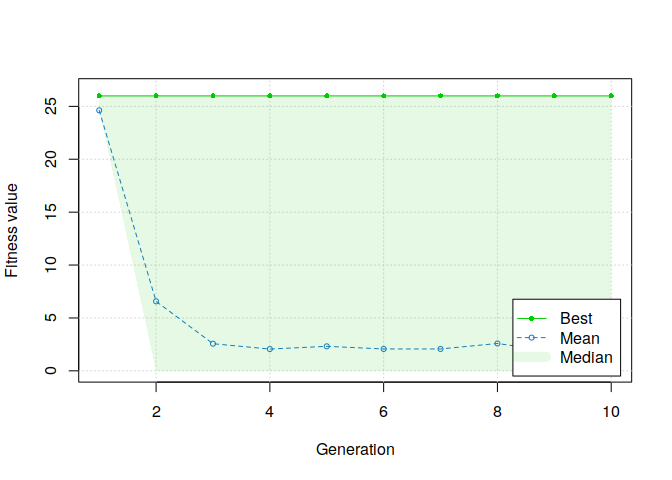
We can observe that the first generation of solutions, the one generated with our custom function, are valid solutions. However, we can also see that the median score directly drop to zero at the second step of the genetic algorithm. This means that more than half of the solutions created from the initial solutions are not valid. It confirms our second assumption about why a basic binary genetic algorithm failed to solve our problem.
Cross-over best solutions🔗
Now we have valid initial solutions, we need to find a way to combine the characteristics of two “parents” valid solutions to generate two “children” solutions which:
- are also valid solutions
- keep sub-characteristics of the two “parents” solutions
This step is called “cross-over” and it’s inspired by chromosomes’ cross-over (even if, in biology, cross-over occurs between two chromosomes of the same individual and not between two chromosomes of two distinct individuals).
We’ll see that, in our case, it’s a tricky step to customize.
Let’s take an example of two valid solutions that we’ll use as “parents”.
ex_parent1 <- example
knitr::kable(matrix(ex_parent1, ncol=nbStudents, byrow=TRUE), "pipe")
| 1 | 1 | 1 | 1 | 0 | 0 | 0 | 0 | 0 | 0 | 0 | 0 | 0 | 0 | 0 | 0 | 0 | 0 | 0 | 0 |
| 0 | 0 | 0 | 0 | 1 | 1 | 1 | 1 | 0 | 0 | 0 | 0 | 0 | 0 | 0 | 0 | 0 | 0 | 0 | 0 |
| 0 | 0 | 0 | 0 | 0 | 0 | 0 | 0 | 1 | 1 | 1 | 1 | 0 | 0 | 0 | 0 | 0 | 0 | 0 | 0 |
| 0 | 0 | 0 | 0 | 0 | 0 | 0 | 0 | 0 | 0 | 0 | 0 | 1 | 1 | 1 | 1 | 0 | 0 | 0 | 0 |
| 0 | 0 | 0 | 0 | 0 | 0 | 0 | 0 | 0 | 0 | 0 | 0 | 0 | 0 | 0 | 0 | 1 | 1 | 1 | 1 |
| 0 | 0 | 0 | 0 | 0 | 0 | 0 | 0 | 0 | 0 | 0 | 0 | 0 | 0 | 0 | 0 | 0 | 0 | 0 | 0 |
cat(fitness(ex_parent1), "\n")
23.67011
ex_parent2 <- c(
0, 0, 0, 0, 0, 0, 0, 0, 0, 0, 1, 0, 1, 0, 1, 0, 1, 0, 1, 0,
0, 0, 0, 0, 0, 0, 0, 0, 0, 0, 0, 1, 0, 1, 0, 1, 0, 1, 0, 1,
1, 0, 1, 0, 1, 0, 1, 0, 1, 0, 0, 0, 0, 0, 0, 0, 0, 0, 0, 0,
0, 1, 0, 1, 0, 1, 0, 1, 0, 1, 0, 0, 0, 0, 0, 0, 0, 0, 0, 0,
0, 0, 0, 0, 0, 0, 0, 0, 0, 0, 0, 0, 0, 0, 0, 0, 0, 0, 0, 0,
0, 0, 0, 0, 0, 0, 0, 0, 0, 0, 0, 0, 0, 0, 0, 0, 0, 0, 0, 0
)
knitr::kable(matrix(ex_parent2, ncol=nbStudents, byrow=TRUE), "pipe")
| 0 | 0 | 0 | 0 | 0 | 0 | 0 | 0 | 0 | 0 | 1 | 0 | 1 | 0 | 1 | 0 | 1 | 0 | 1 | 0 |
| 0 | 0 | 0 | 0 | 0 | 0 | 0 | 0 | 0 | 0 | 0 | 1 | 0 | 1 | 0 | 1 | 0 | 1 | 0 | 1 |
| 1 | 0 | 1 | 0 | 1 | 0 | 1 | 0 | 1 | 0 | 0 | 0 | 0 | 0 | 0 | 0 | 0 | 0 | 0 | 0 |
| 0 | 1 | 0 | 1 | 0 | 1 | 0 | 1 | 0 | 1 | 0 | 0 | 0 | 0 | 0 | 0 | 0 | 0 | 0 | 0 |
| 0 | 0 | 0 | 0 | 0 | 0 | 0 | 0 | 0 | 0 | 0 | 0 | 0 | 0 | 0 | 0 | 0 | 0 | 0 | 0 |
| 0 | 0 | 0 | 0 | 0 | 0 | 0 | 0 | 0 | 0 | 0 | 0 | 0 | 0 | 0 | 0 | 0 | 0 | 0 | 0 |
cat(fitness(ex_parent2))
24.39361
In a basic binary genetic algorithm, as illustrated in the figure below proposed by Alamri and Alharbi (2020), the “cross-over” function will generally split the “parents” in two and generate the “children” with the four sub-parts.
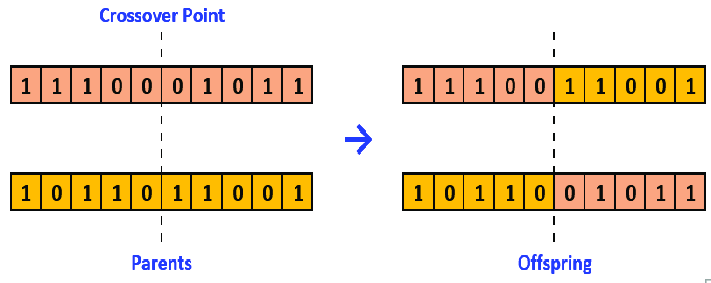
Let’s apply this process to our example.
split <- length(ex_parent1) %/% 2
ex_child1 <- append(ex_parent1[1:split], ex_parent2[(split+1):length(ex_parent1)])
knitr::kable(matrix(ex_child1, ncol=nbStudents, byrow=TRUE), "pipe")
| 1 | 1 | 1 | 1 | 0 | 0 | 0 | 0 | 0 | 0 | 0 | 0 | 0 | 0 | 0 | 0 | 0 | 0 | 0 | 0 |
| 0 | 0 | 0 | 0 | 1 | 1 | 1 | 1 | 0 | 0 | 0 | 0 | 0 | 0 | 0 | 0 | 0 | 0 | 0 | 0 |
| 0 | 0 | 0 | 0 | 0 | 0 | 0 | 0 | 1 | 1 | 1 | 1 | 0 | 0 | 0 | 0 | 0 | 0 | 0 | 0 |
| 0 | 1 | 0 | 1 | 0 | 1 | 0 | 1 | 0 | 1 | 0 | 0 | 0 | 0 | 0 | 0 | 0 | 0 | 0 | 0 |
| 0 | 0 | 0 | 0 | 0 | 0 | 0 | 0 | 0 | 0 | 0 | 0 | 0 | 0 | 0 | 0 | 0 | 0 | 0 | 0 |
| 0 | 0 | 0 | 0 | 0 | 0 | 0 | 0 | 0 | 0 | 0 | 0 | 0 | 0 | 0 | 0 | 0 | 0 | 0 | 0 |
cat(fitness(ex_child1), "\n")
0
ex_child2 <- append(ex_parent2[1:split], ex_parent1[(split+1):length(ex_parent1)])
knitr::kable(matrix(ex_child2, ncol=nbStudents, byrow=TRUE), "pipe")
| 0 | 0 | 0 | 0 | 0 | 0 | 0 | 0 | 0 | 0 | 1 | 0 | 1 | 0 | 1 | 0 | 1 | 0 | 1 | 0 |
| 0 | 0 | 0 | 0 | 0 | 0 | 0 | 0 | 0 | 0 | 0 | 1 | 0 | 1 | 0 | 1 | 0 | 1 | 0 | 1 |
| 1 | 0 | 1 | 0 | 1 | 0 | 1 | 0 | 1 | 0 | 0 | 0 | 0 | 0 | 0 | 0 | 0 | 0 | 0 | 0 |
| 0 | 0 | 0 | 0 | 0 | 0 | 0 | 0 | 0 | 0 | 0 | 0 | 1 | 1 | 1 | 1 | 0 | 0 | 0 | 0 |
| 0 | 0 | 0 | 0 | 0 | 0 | 0 | 0 | 0 | 0 | 0 | 0 | 0 | 0 | 0 | 0 | 1 | 1 | 1 | 1 |
| 0 | 0 | 0 | 0 | 0 | 0 | 0 | 0 | 0 | 0 | 0 | 0 | 0 | 0 | 0 | 0 | 0 | 0 | 0 | 0 |
cat(fitness(ex_child2))
0
We can observe that the generated “children” solutions, with this method, are not valid at all. This explains the direct decrease in fitness scores that we observed before.
To customize the cross-over function, we need to understand the characteristics of a solution that we want “children” solutions to inherit from their “parents” solutions.
In our use case, we have two main characteristics that “children” solutions could inherit from their “parents” solutions:
- the number of students by group
- how the students are grouped together
To simplify the cross-over process, let’s keep the number of students from parents to children (children1 will have the same number of students in each group than parent1, and so on for parent2). This characteristic allows us to be sure to generate solutions with valid group sizes.
# initialize child with a list of zero
ex_child1 <- rep(0, length(ex_parent1))
# get groups of students in parent1
groups <- matrix(ex_parent1, ncol = nbStudents, byrow = TRUE)
# compute the number of students by groups
nbStudentsByGroup <- rowSums(groups)
# remove empty groups
nbStudentsByGroup <- nbStudentsByGroup[nbStudentsByGroup != 0]
Concerning how the students are grouped together, we can first observe that the composition of the last group is implied by the other groups. So we can focus on the composition of $nbGroups - 1$ groups.
To keep a sub-part of students grouped together in the first parent, we can simply keep the composition of $(nbGroups−1)/2$ random groups from this first parent.
# compute the number of groups will keep from parent 1
nbGroupKept <- (length(nbStudentsByGroup) - 1) %/% 2
# choose random groups in parent1 to keep in child
groupKeptIds <- sample(1:length(nbStudentsByGroup), nbGroupKept, replace = FALSE)
# to trace the groups not keept from parent1
groupIdsLeft <- 1:length(nbStudentsByGroup)
# to trace the students not grouped yet
studentIdsLeft <-1:nbStudents
# for each group choose in parent1
for(groupKeptId in groupKeptIds){
# get the corresponding row
groupKept <- groups[groupKeptId,]
# get the students in the group
studentIds <- which(groupKept == 1)
# for each student
for(studentId in studentIds){
# set the corresponding cell at 1 in the child
ex_child1[nbStudents * (groupKeptId-1) + studentId] = 1
# remove the student from the list of students not grouped yet
studentIdsLeft = studentIdsLeft[studentIdsLeft != studentId]
}
# remove group from groups not completed yet
groupIdsLeft = groupIdsLeft[groupIdsLeft != groupKeptId]
}
knitr::kable(matrix(ex_child1, ncol=nbStudents, byrow=TRUE), "pipe")
| 0 | 0 | 0 | 0 | 0 | 0 | 0 | 0 | 0 | 0 | 0 | 0 | 0 | 0 | 0 | 0 | 0 | 0 | 0 | 0 |
| 0 | 0 | 0 | 0 | 0 | 0 | 0 | 0 | 0 | 0 | 0 | 0 | 0 | 0 | 0 | 0 | 0 | 0 | 0 | 0 |
| 0 | 0 | 0 | 0 | 0 | 0 | 0 | 0 | 1 | 1 | 1 | 1 | 0 | 0 | 0 | 0 | 0 | 0 | 0 | 0 |
| 0 | 0 | 0 | 0 | 0 | 0 | 0 | 0 | 0 | 0 | 0 | 0 | 0 | 0 | 0 | 0 | 0 | 0 | 0 | 0 |
| 0 | 0 | 0 | 0 | 0 | 0 | 0 | 0 | 0 | 0 | 0 | 0 | 0 | 0 | 0 | 0 | 1 | 1 | 1 | 1 |
| 0 | 0 | 0 | 0 | 0 | 0 | 0 | 0 | 0 | 0 | 0 | 0 | 0 | 0 | 0 | 0 | 0 | 0 | 0 | 0 |
Then, and it’s the tricky part, we have to get some characteristics from parent 2. To do so, we can search, for each group not completed yet, for a subset of students that are grouped together in the second parent (or several subsets of students grouped together in the second parent until obtaining enough students).
groupsInParent2 <- matrix(ex_parent2, ncol = nbStudents, byrow = TRUE)
studentsByGroupsInParent2 <- rowSums(groupsInParent2)
nbGroupsInParent2 <- length(studentsByGroupsInParent2[studentsByGroupsInParent2 != 0])
# for the (nbStudents - 1) / 2 groups not completed yet
while(length(groupIdsLeft) > 1){
# choose a group
groupId <- sample(groupIdsLeft, 1)
# get the size of the group in parent 1
groupSize <- nbStudentsByGroup[groupId]
# while the corresponding group in child is not completed
while(groupSize > 0){
# get a random group g2 in parent 2
groupIdInParent2 <- sample(1:nbGroupsInParent2, 1)
# get the students in the group g2
studentIds <- which(groupsInParent2[groupIdInParent2, ] == 1)
# get the intersection between g2 and the students not grouped yet in the child
studentSelectedIds <- intersect(studentIds, studentIdsLeft)
# get a subset of this intersection if necessary
if(length(studentSelectedIds) > groupSize)
studentSelectedIds <- sample(studentSelectedIds, groupSize, replace = FALSE)
# complete the child with students of the intersection
for(studentId in studentSelectedIds){
ex_child1[nbStudents * (groupId-1) + studentId] = 1
studentIdsLeft = studentIdsLeft[studentIdsLeft != studentId]
}
# to know if we need more students to complete the group
groupSize = groupSize - length(studentSelectedIds)
}
groupIdsLeft = groupIdsLeft[groupIdsLeft != groupId]
}
knitr::kable(matrix(ex_child1, ncol=nbStudents, byrow=TRUE), "pipe")
| 0 | 0 | 0 | 0 | 0 | 0 | 0 | 0 | 0 | 0 | 0 | 0 | 1 | 1 | 1 | 1 | 0 | 0 | 0 | 0 |
| 1 | 0 | 1 | 0 | 1 | 0 | 1 | 0 | 0 | 0 | 0 | 0 | 0 | 0 | 0 | 0 | 0 | 0 | 0 | 0 |
| 0 | 0 | 0 | 0 | 0 | 0 | 0 | 0 | 1 | 1 | 1 | 1 | 0 | 0 | 0 | 0 | 0 | 0 | 0 | 0 |
| 0 | 0 | 0 | 0 | 0 | 0 | 0 | 0 | 0 | 0 | 0 | 0 | 0 | 0 | 0 | 0 | 0 | 0 | 0 | 0 |
| 0 | 0 | 0 | 0 | 0 | 0 | 0 | 0 | 0 | 0 | 0 | 0 | 0 | 0 | 0 | 0 | 1 | 1 | 1 | 1 |
| 0 | 0 | 0 | 0 | 0 | 0 | 0 | 0 | 0 | 0 | 0 | 0 | 0 | 0 | 0 | 0 | 0 | 0 | 0 | 0 |
Finally, now we have $nbGroups − 1$ completed, we just have to complete the last group with students not grouped yet.
for(studentId in studentIdsLeft){
groupId <- groupIdsLeft[1]
ex_child1[nbStudents * (groupId-1) + studentId] = 1
}
knitr::kable(matrix(ex_child1, ncol=nbStudents, byrow=TRUE), "pipe")
| 0 | 0 | 0 | 0 | 0 | 0 | 0 | 0 | 0 | 0 | 0 | 0 | 1 | 1 | 1 | 1 | 0 | 0 | 0 | 0 |
| 1 | 0 | 1 | 0 | 1 | 0 | 1 | 0 | 0 | 0 | 0 | 0 | 0 | 0 | 0 | 0 | 0 | 0 | 0 | 0 |
| 0 | 0 | 0 | 0 | 0 | 0 | 0 | 0 | 1 | 1 | 1 | 1 | 0 | 0 | 0 | 0 | 0 | 0 | 0 | 0 |
| 0 | 1 | 0 | 1 | 0 | 1 | 0 | 1 | 0 | 0 | 0 | 0 | 0 | 0 | 0 | 0 | 0 | 0 | 0 | 0 |
| 0 | 0 | 0 | 0 | 0 | 0 | 0 | 0 | 0 | 0 | 0 | 0 | 0 | 0 | 0 | 0 | 1 | 1 | 1 | 1 |
| 0 | 0 | 0 | 0 | 0 | 0 | 0 | 0 | 0 | 0 | 0 | 0 | 0 | 0 | 0 | 0 | 0 | 0 | 0 | 0 |
cat(fitness(ex_child1))
23.5117
In this way, we keep the subsets of students grouped together in both “parents”, while keeping a valid number of students in each group.
This gives us the following function.
group_crossover = function(object, parents){
# get parents
parents <- object@population[parents,,drop = FALSE]
# get number of paremeters in parents
n <- ncol(parents)
# initialize children with matrice of zeros
children <- matrix(rep(0, 2*n), nrow = 2, ncol = n)
# initialize children fitness at NA
# (this will force GA function to compute fitness for the children)
childrenFitness <- rep(NA, 2)
# for each children to generate
for(i in 1:nrow(children)){
## STEP 1: get group sizes from parent 1 ##
# get parent1
parent1 <- parents[i,]
# get groups of students in parent1
groups <- matrix(parent1, ncol = nbStudents, byrow = TRUE)
# compute the number of students by groups
nbStudentsByGroup <- rowSums(groups)
# remove empty groups
nbStudentsByGroup <- nbStudentsByGroup[nbStudentsByGroup != 0]
## STEP 2: get groups structure from parent 1 ##
# compute the number of groups will keep from parent 1
nbGroupKept <- (length(nbStudentsByGroup) - 1) %/% 2
# choose random groups in parent1 to keep in child
groupKeptIds <- sample(1:length(nbStudentsByGroup), nbGroupKept, replace = FALSE)
# to trace the groups not keept from parent1
groupIdsLeft <- 1:length(nbStudentsByGroup)
# to trace the students not grouped yet
studentIdsLeft <-1:nbStudents
# for each group choosen in parent1
for(groupKeptId in groupKeptIds){
# get the corresponding row
groupKept <- groups[groupKeptId,]
# get the students in the group
studentIds <- which(groupKept == 1)
# for each student
for(studentId in studentIds){
# set the corresponding cell at 1 in the child
children[i, nbStudents * (groupKeptId-1) + studentId] = 1
# remove the student from the list of students not grouped yet
studentIdsLeft = studentIdsLeft[studentIdsLeft != studentId]
}
# remove group from groups not completed yet
groupIdsLeft = groupIdsLeft[groupIdsLeft != groupKeptId]
}
## STEP 3: get groups structure from parent 2 ##
# get parent 2
parent2 <- if(i==1) parents[2,] else parents[1,]
groupsInParent2 <- matrix(parent2, ncol = nbStudents, byrow = TRUE)
studentsByGroupsInParent2 <- rowSums(groupsInParent2)
nbGroupsInParent2 <- length(studentsByGroupsInParent2[studentsByGroupsInParent2 != 0])
# for the (nbStudents - 1) / 2 groups not completed yet
while(length(groupIdsLeft) > 1){
# choose a group
groupId <- sample(groupIdsLeft, 1)
# get the size of the group in parent 1
groupSize <- nbStudentsByGroup[groupId]
# while the corresponding group in child is not completed
while(groupSize > 0){
# get a random group g2 in parent 2
groupIdInParent2 <- sample(1:nbGroupsInParent2, 1)
# get the students in the group g2
studentIds <- which(groupsInParent2[groupIdInParent2, ] == 1)
# get the intersection between g2 and the students not grouped yet in the child
studentSelectedIds <- intersect(studentIds, studentIdsLeft)
# get a subset of this intersection if necessary
if(length(studentSelectedIds) > groupSize)
studentSelectedIds <- sample(studentSelectedIds, groupSize, replace = FALSE)
# complete the child with students of the intersection
for(studentId in studentSelectedIds){
children[i, nbStudents * (groupId-1) + studentId] = 1
studentIdsLeft = studentIdsLeft[studentIdsLeft != studentId]
}
# to know if we need more students to complete the group
groupSize = groupSize - length(studentSelectedIds)
}
groupIdsLeft = groupIdsLeft[groupIdsLeft != groupId]
}
## STEP 4: complete last group with students not grouped yet ##
for(studentId in studentIdsLeft){
groupId <- groupIdsLeft[1]
children[i, nbStudents * (groupId-1) + studentId] = 1
}
}
return(list(children=children, fitness=childrenFitness))
}
Let’s try the genetic algorithm with this custom cross-over function, in combination with our custom initialization function.
GA=ga(
type='binary',
fitness=fitness,
nBits=nbStudents*nbGroupsMax,
population = group_population,
crossover = group_crossover,
maxiter=10,
popSize=100,
seed=seed,
keepBest=TRUE,
monitor=FALSE
)
plot(GA, ylim=c(0, mean(students$rmet)))
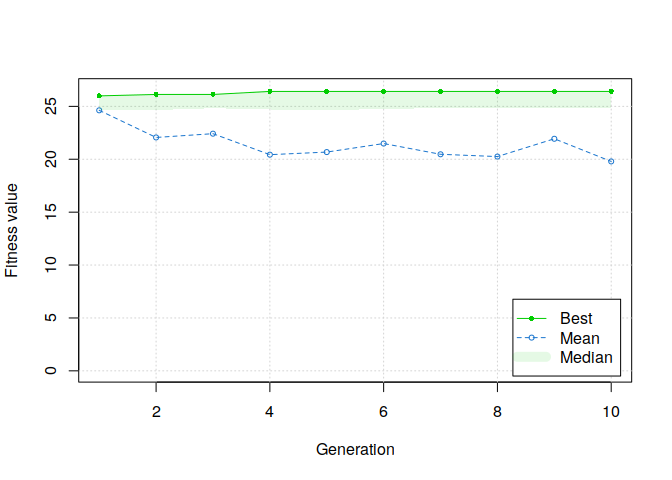
We can observe that the median of fitness scores doesn’t directly drop to zero after the first generation. Moreover, the best solutions increase generation after generation. However, the mean fitness score still decreases generation after generation.
This is due to the mutations applied by the genetic algorithm on the solutions generated by our cross-over function. As introduced before, in our problem it’s easy to obtain a non-valid solution by simply changing one parameter.
Mutate solutions🔗
The last step we need to customize is the mutation step.
The idea of this step is to apply, once children are created, a little modification to generate more diversity in the solutions tested. Without mutation, there is a risk that the genetic algorithm stays on local optimum solutions, even with the cross-over step.
In a basic binary genetic algorithm, a mutation consists to change the value of one random parameter from 0 to 1, or from 1 to 0. However, applying this kind of mutation to a valid solution to our problem can easily lead to a non-valid solution. For example, it could set a student to two different groups or no group at all, or simply create groups too small or too big.
In our case, the idea is simply to choose two random students from two different groups and exchange them.
To do so, we’ll use the following function. It chooses two random groups, then one random student in each of these two groups. Then, it updates the solution to correspond to an exchange of the two selected students.
group_mutation <- function(object, solution){
# get the solution to mutate
mutate <- solution <- as.vector(object@population[solution,])
# transform to matrices to get groups
groups <- matrix(solution, ncol = nbStudents, byrow = TRUE)
# remove empty groups (useless)
groups <- groups[rowSums(groups) != 0, ]
# sample two random groups
selectedGroupIds <- sample(1:nrow(groups), 2, replace = FALSE)
# select students to exchange
group1 <- selectedGroupIds[1]
student1 <- sample(which(groups[group1,] == 1), 1)
group2 <- selectedGroupIds[2]
student2 <- sample(which(groups[group2,] == 1), 1)
# remove student from their groups
mutate[nbStudents * (group1-1) + student1] = 0
mutate[nbStudents * (group2-1) + student2] = 0
# add them into the other groups
mutate[nbStudents * (group1-1) + student2] = 1
mutate[nbStudents * (group2-1) + student1] = 1
return(mutate)
}
Let’s test the genetic algorithm with this custom mutation function, in combination with our initialization and cross-over functions.
GA=ga(
type='binary',
fitness=fitness,
nBits=nbStudents*nbGroupsMax,
population = group_population,
crossover = group_crossover,
mutation = group_mutation,
maxiter=300,
popSize=100,
seed=seed,
keepBest=TRUE,
monitor=FALSE
)
plot(GA, ylim=c(0, mean(students$rmet)))

AAAND IT WORKS!
Moreover, if we summarize the results of the genetic algorithm, several solutions have been found.
summary(GA)
-- Genetic Algorithm -------------------
GA settings:
Type = binary
Population size = 100
Number of generations = 300
Elitism = 5
Crossover probability = 0.8
Mutation probability = 0.1
GA results:
Iterations = 300
Fitness function value = 26.49226
Solutions = x1 x2 x3 x4 x5 x6 x7 x8 x9 x10 ... x119 x120
[1,] 0 1 0 0 0 0 1 0 0 0 ... 0 0
[2,] 0 0 1 0 0 0 0 0 0 0 ... 0 0
[3,] 0 0 0 0 0 0 0 0 0 0 ... 0 0
[4,] 0 0 1 0 0 0 0 1 0 0 ... 0 0
[5,] 0 1 0 0 0 0 1 0 0 0 ... 0 0
However, sets of 0 and 1 are difficult to analyze.
Visualizing solutions🔗
To better visualize the solutions, we can plot them as a graph/network of students. To do so, we’ll use the R package igraph.
library(igraph)
First, we need to represent the students with their RMET scores. Each student are represented as nodes/vertices of the graph, with their id and RMET score as labels.
g <- make_empty_graph(directed = FALSE)
for(i in 1:nrow(students))
g <- add_vertices(g, 1, label=paste(i, " (", students[i,]$rmet, ")", sep=""))
# plot graph
co <- layout_nicely(g)
plot(0,
type="n",
ann=FALSE, axes=FALSE,
xlim=extendrange(co[,1]),
ylim=extendrange(co[,2])
)
plot(g, layout=co, rescale=FALSE, add=TRUE,
vertex.shape="rectangle",
vertex.size=strwidth(V(g)$label) * 100,
vertex.size2=strheight(V(g)$label) * 100 * 1.5,
edge.width=5
)

Then, each edge of the graph will represent the fact that two students are in the same group.
solution <- GA@solution[1,]
m <- matrix(solution, ncol = nbStudents, byrow = TRUE)
# for each group
for(i in 1:nbGroupsMax){
# get the students in the group
studentIds <- which(m[i, ] == 1)
if(length(studentIds) > 0){ # group not empty
edges <- c()
# for each student if the group
for(j in 1:length(studentIds)){
edges[length(edges)+1] <- studentIds[j]
if(j < length(studentIds)) # if not last student
# connect students j and j+#
edges[length(edges)+1] <- studentIds[j+1]
else # if last student, connect it to the first
edges[length(edges)+1] <- studentIds[1]
}
g <- add_edges(g, edges)
}
}
# plot graph
co <- layout_nicely(g)
plot(0,
type="n",
ann=FALSE, axes=FALSE,
xlim=extendrange(co[,1]),
ylim=extendrange(co[,2])
)
plot(g, layout=co, rescale=FALSE, add=TRUE,
vertex.shape="rectangle",
vertex.size=strwidth(V(g)$label) * 100,
vertex.size2=strheight(V(g)$label) * 100 * 1.5,
edge.width=5
)
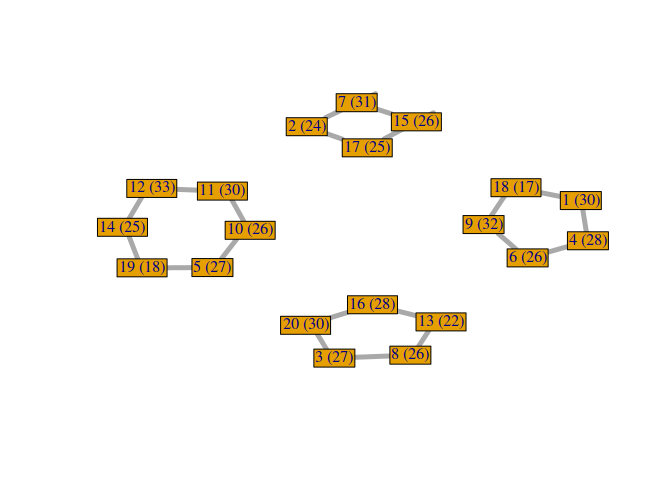
Now, it could be interesting to plot the RMET mean score of each group. To do so, we compute the RMET mean and the center in the graph of each group.
co <- layout_nicely(g)
plot(0,
type="n",
ann=FALSE, axes=FALSE,
xlim=extendrange(co[,1]),
ylim=extendrange(co[,2])
)
plot(g, layout=co, rescale=FALSE, add=TRUE,
vertex.shape="rectangle",
vertex.size=strwidth(V(g)$label) * 100,
vertex.size2=strheight(V(g)$label) * 100 * 1.5,
edge.width=5
)
rmet_means <- c()
for(i in 1:nbGroupsMax){
studentIds <- which(m[i, ] == 1)
if(length(studentIds) > 0){
rmet_means[i] <- mean(students[m[i,]==1,]$rmet)
studentCoors <- co[studentIds,]
xcoor <- sum(studentCoors[,1]) / nrow(studentCoors)
ycoor <- sum(studentCoors[,2]) / nrow(studentCoors)
text(xcoor, ycoor, round(rmet_means[i], 1))
}
}

Finally, we can aggregate all these elements in a function to plot any solution.
display_groupmaking <- function(solution){
g <- make_empty_graph(directed = FALSE)
for(i in 1:nrow(students))
g <- add_vertices(g, 1, label=paste(i, " (", students[i,]$rmet, ")", sep=""), vertex.size=50)
m <- matrix(solution, ncol = nbStudents, byrow = TRUE)
rmet_means <- c()
for(i in 1:nbGroupsMax){
studentIds <- which(m[i, ] == 1)
if(length(studentIds) > 0){
rmet_means[i] <- mean(students[m[i,]==1,]$rmet)
edges <- c()
for(j in 1:length(studentIds)){
edges[length(edges)+1] <- studentIds[j]
if(j < length(studentIds))
edges[length(edges)+1] <- studentIds[j+1]
else
edges[length(edges)+1] <- studentIds[1]
}
g <- add_edges(g, edges)
}
}
# compute macro mean and standard deviation
macro_rmet_mean <- mean(rmet_means)
macro_rmet_sd <- sd(rmet_means)
co <- layout_nicely(g)
plot(0,
type="n",
ann=TRUE, axes=FALSE,
xlab="",
ylab="",
xlim=extendrange(co[,1]),
ylim=extendrange(co[,2]),
main=paste("Score = ", macro_rmet_mean - macro_rmet_sd),
sub=paste("Macro mean =", macro_rmet_mean, "±", macro_rmet_sd)
)
plot(g, layout=co, rescale=FALSE, add=TRUE,
vertex.shape="rectangle",
vertex.size=strwidth(V(g)$label) * 100,
vertex.size2=strheight(V(g)$label) * 100 * 1.5,
edge.width=5
)
## add rmet’s mean for each group
for(i in 1:nbGroupsMax){
studentIds <- which(m[i, ] == 1)
if(length(studentIds) > 0){
studentCoors <- co[studentIds,]
xcoor <- sum(studentCoors[,1]) / nrow(studentCoors)
ycoor <- sum(studentCoors[,2]) / nrow(studentCoors)
text(xcoor, ycoor, round(rmet_means[i], 1))
}
}
}
Now, we can visualize the different solutions found by our custom genetic algorithm.
for(i in 1:nrow(GA@solution)){
display_groupmaking(GA@solution[i,])
}
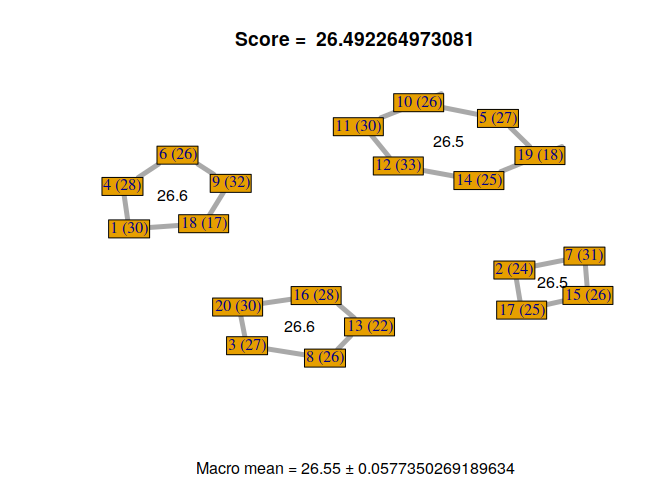
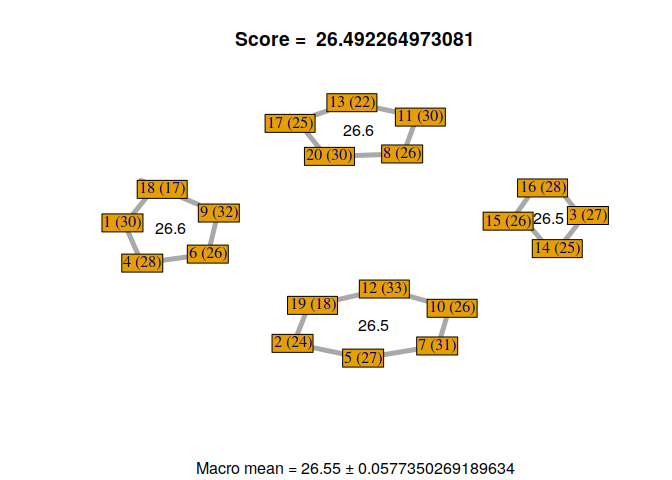
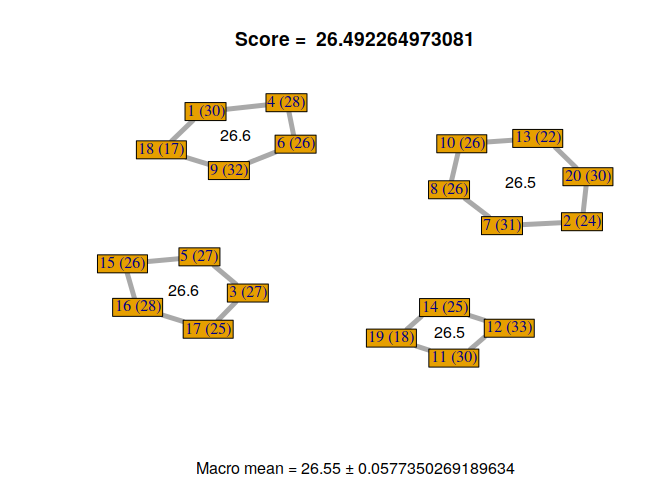
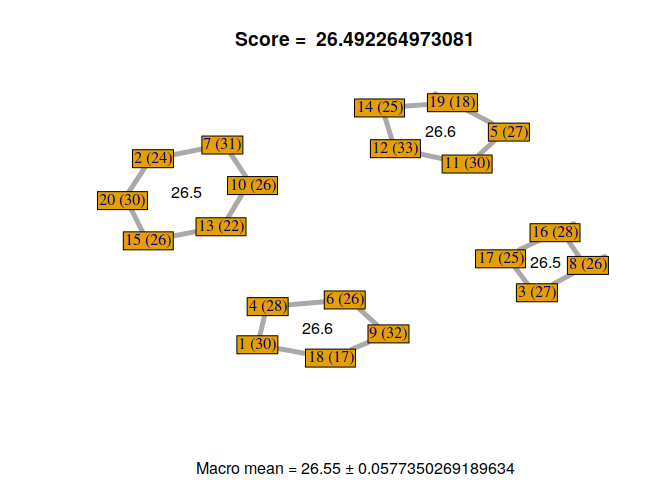
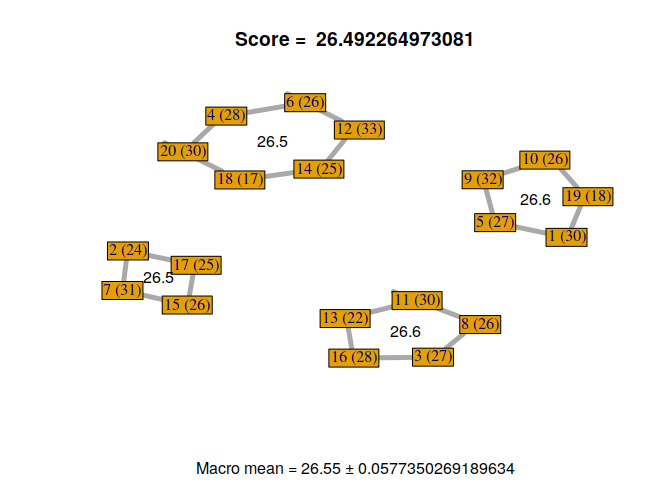
We can observe that not all solutions have been found by the genetic algorithm. Some students with the same RMET scores can be exchanged. But, it’s not a problem because it gives us a sample of good solutions to our problem. Moreover, we can exchange some students if necessary, without losing scores, to find a configuration that satisfies everyone.
It could be interesting to use this visualization to observe the different generations of solutions generated by the genetic algorithm. For example, it’s possible to define, with the GA package, a “monitor” function. However, this blog post is already way too long, so maybe another time.
Conclusion🔗
I had multiple objectives with this blog post. First, I wanted to practice genetic algorithms. It’s a type of algorithm I found very promising, especially genetic programming. But, nowadays, I work almost entirely on machine learning and deep learning.
Secondly, I wanted to find a way to create homogeneous student groups. As I say in the introduction, it’s a common problem for teachers. I have sometimes to deal with it, and its hard to find a solution that satistfies everyone. In addition, it was possible to apply a genetic algorithm to this problem, so it was the perfect occasion to test it.
Thirdly, I wanted to popularise how a genetic algorithm works with a practical use case. To do so, I tried to narrate the different steps I went through. But, maybe, it would be more understandable with another use case.
Besides, I had to make some choices that could be not optimal. For example, the choice of representing this problem as a binary problem (I talk about that in the next section). Also, for the cross-over step, I chose to keep the configuration of the parents’ group size. This is not a “bad” choice. It stays coherent with the idea to keep sub-characteristics of parents in children. But, it mechanically decreases the diversity of group sizes in solutions. Generation after generation, the genetic algorithm converges to a certain configuration of group sizes, without the possibility to explore other configurations of group sizes. It could be interesting to create mutation functions that could divide large groups or merge small groups, in addition to the mutation function which exchange two students.
More generally, as I said in the introduction, genetic algorithms are quite interesting to find a set of parameters that optimize the result of a fitness function. For example, as proposed by Stanley and Miikkulainen (2002), genetic algorithms can be used in machine learning to find the best structures of neural networks (the number of neurons, the number of layers, etc. can be considered as parameters to optimize).
Besides, genetic algorithms are also interesting to find solutions to multi-objectives problems. As I briefly said when I presented the customizable steps of genetic algorithms, it’s possible to have several fitness scores to evaluate a solution and look for Pareto optimal solutions at the selection phase. It’s more appropriate than trying to do some weighted average, which is generally the worst thing to do. Especially if the different objectives have nothing in common and cannot compensate for each other. Unfortunately, our use case didn’t need several objectives to be solved. So, I didn’t have the opportunity to try a multi-objectives genetic algorithm. Maybe another time.
To conclude, I hope this blog post helped the few people who read it to better understand genetic algorithms and how to use/customize them.
Bonus: another way to solve our problem with the Genetic Algorithm🔗
To be totally honest with you I had to show you another way, way more easier, to solve our problem. Maybe some of the readers already find it. It simply consist to represents the solutions to our problem as a list of size $nbStudents$ and to associating a number between 1 and $nbGroupsMax$ to each student.
variation_example <- c(1,1,1,1,2,2,2,2,3,3,3,3,4,4,4,4,5,5,5,5)
This way, the number of combinations tested by the genetic algorithm will be:
$$ nbGroupsMax^{nbStudents} $$
With our use case, it gives us:
cat(nbGroupsMax^nbStudents, "\n")
3.656158e+15
cat(totNbCombinations / nbGroupsMax^nbStudents)
0.001898546
The number of valid group combinations is still a fraction of all combinations tested by the genetic algorithm, but largely less than before.
Now, we just have to rewrite our fitness function as follows:
variation_fitness <- function(solution){
# compute info for each group
counts <- c()
means <- c()
for(i in 1:nbGroupsMax){
if(length(solution[solution == i]) > 0){
counts[length(counts) + 1] <- length(solution[solution == i])
studentIds <- which(solution == i)
means[length(means) + 1] <- mean(students[studentIds,]$rmet)
}
}
# check veto conditions
if(any(counts < minStudentsByGroup) || any(counts > maxStudentsByGroup))
return(0)
# return scores - penalty
return(mean(means) - sd(means))
}
cat(variation_fitness(variation_example))
23.67011
Then, we can apply the genetic algorithm to this representation of our problem. I didn’t find how to do this with the GA package. For this example, I’ll use the package rgenoud, proposed by Mebane and Sekhon (2011), which allows parameters to be integers.
library("rgenoud")
# Define the domain of each parameter
mat <- matrix(
rep(c(1,nbGroupsMax),nbStudents),
nrow = nbStudents,
ncol = 2,
byrow = TRUE
)
variation_GA <- genoud(
variation_fitness,
nvars = nbStudents,
max = TRUE,
pop.size = 100,
max.generations = 400,
hard.generation.limit = FALSE,
Domains = mat,
boundary.enforcement = 2,
data.type.int = TRUE,
print.level = 0
)
cat(variation_GA$value, "\n")
26.18434
cat(variation_GA$par)
3 5 1 6 6 6 6 3 1 2 1 2 2 5 6 5 3 6 1 5
We can see that, with this representation of our solutions, the genetic algorithm finds solutions without the need to be customized. However, it’s still more relevant to customize it, to stay only on valid solutions, and also because with more students it doesn’t work (I let you try it).
The reason I didn’t use this representation in this blog was only that I found it more interesting, from an “educational” point of view, to start from something that doesn’t work at all. But, I also had to show that there is not only one way to find solutions to a problem.
References🔗
Abdel-Basset, Mohamed, Laila Abdel-Fatah, and Arun Kumar Sangaiah. 2018. “Chapter 10 - Metaheuristic Algorithms: A Comprehensive Review.” In Computational Intelligence for Multimedia Big Data on the Cloud with Engineering Applications, edited by Arun Kumar Sangaiah, Michael Sheng, and Zhiyong Zhang, 185–231. Intelligent Data-Centric Systems. Academic Press. https://doi.org/https://doi.org/10.1016/B978-0-12-813314-9.00010-4.
Alamri, Basem, and Yasser Alharbi. 2020. “A Framework for Optimum Determination of LCL-Filter Parameters for n-Level Voltage Source Inverters Using Heuristic Approach.” IEEE Access 8 (January): 209212–23. https://doi.org/10.1109/ACCESS.2020.3038583.
Fan, Xumei, William Sayers, Shujun Zhang, Zhiwu Han, Luquan Ren, and Hassan Chizari. 2020. “Review and Classification of Bio-Inspired Algorithms and Their Applications.” Journal of Bionic Engineering 17 (3): 611–31. https://doi.org/https://doi.org/10.1007/s42235-020-0049-9.
Kynast, Jana, Maryna Polyakova, Eva Maria Quinque, Andreas Hinz, Arno Villringer, and Matthias L. Schroeter. 2021. “Age- and Sex-Specific Standard Scores for the Reading the Mind in the Eyes Test.” Frontiers in Aging Neuroscience 12. https://doi.org/10.3389/fnagi.2020.607107.
Mebane, Walter, and Jasjeet Sekhon. 2011. “Genetic Optimization Using Derivatives: The Rgenoud Package for r.” Journal Of Statistical Software 42 (June). https://doi.org/10.18637/jss.v042.i11.
Riedl, Christoph, Young Ji Kim, Pranav Gupta, Thomas W Malone, and Anita Williams Woolley. 2021. “Quantifying Collective Intelligence in Human Groups.” Proceedings of the National Academy of Sciences 118 (21): e2005737118. https://www.pnas.org/doi/full/10.1073/pnas.2005737118.
Scrucca, Luca. 2013. “GA: A Package for Genetic Algorithms in R.” Journal of Statistical Software 53 (4): 1–37. https://doi.org/10.18637/jss.v053.i04.
Stanley, Kenneth O, and Risto Miikkulainen. 2002. “Evolving Neural Networks Through Augmenting Topologies.” Evolutionary Computation 10 (2): 99–127. https://doi.org/10.1162/106365602320169811.
Warrier, Varun, Richard AI Bethlehem, and Simon Baron-Cohen. 2017. “The ‘Reading the Mind in the Eyes’ Test (RMET).” In Encyclopedia of Personality and Individual Differences, edited by Virgil Zeigler-Hill and Todd K. Shackelford, 1–5. Cham: Springer International Publishing. https://doi.org/10.1007/978-3-319-28099-8_549-1.